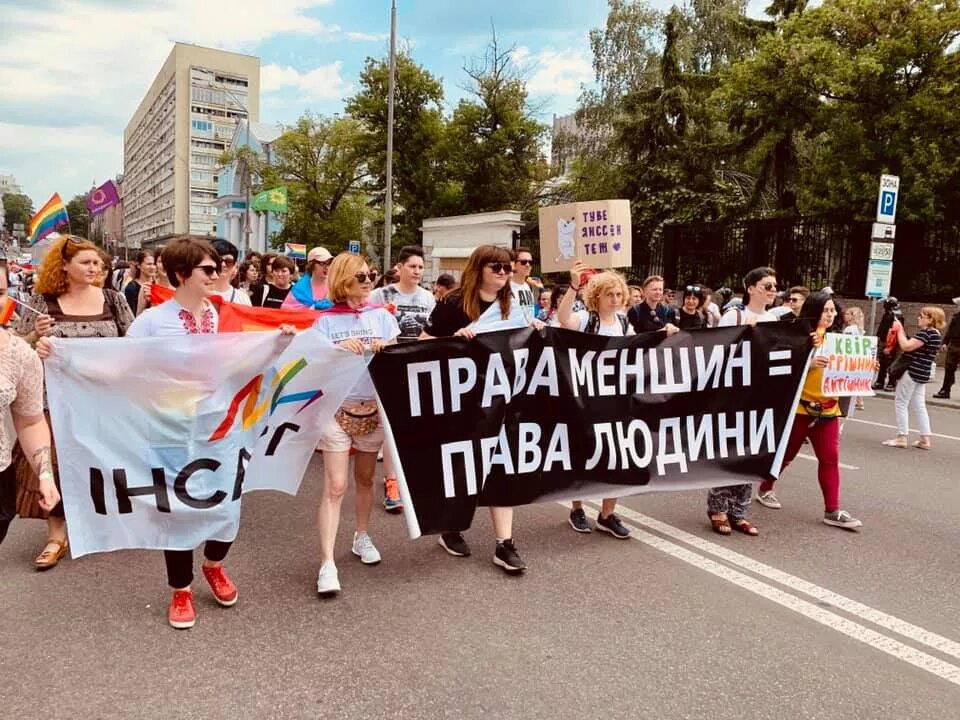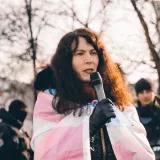
On December 10, a private discussion “LGBT and Feminism: Why Does Gender Equality Bother Conservatives?” was held as part of the Human Rights (un)conference.
The speakers included the head of Insight NGO Olena Shevchenko, coordinator of transgender activity in Insight NGO Inna Iryskina and coordinator of the Gender Democracy program in Heinrich Boell Foundation, Kyiv Office — Ukraine, Anna Dovgopol. They spoke about human rights in the context of gender equality, feminism and the fight for equality for LGBTQI+ people in Ukraine. The discussion was moderated by editor-in-chief of Update media outlet Taisia Herasymova. You can watch a recording of the discussion or read notes below.
Human rights are universal. Yet, when we speak about human rights without naming specific groups suffering from violence and discrimination, the discussion makes no sense. In today’s conversation we deliberately combined LGBT rights and feminism because our organization (Insight NGO) works both on gender equality and protection of LGBT rights. The concept of human rights is that all people have equal rights, i.e. their rights are the same. It’s not to say that all people are the same. We have this interesting Soviet background when everyone was equal in communism. But the truth is, communism is not about equality. The idea of equality was announced, but it only worked among poorer social groups, while the rich still lived differently. There was no real equality for all people.
The question that we are asking today is, why do we have to stand up for people’s rights to be equal to other groups? Some wonder, “Why do you protect those people specifically?” When somebody says “those people,” what do we hear in those words? This attitude is hardly about equality. Or, when somebody says, “I’m not against homosexuality/feminism, but…”, this “but” means that the person actually does mind these things, and the but will be followed by a long list of reasons why.
Now it’s no longer fashionable to be homophobic, transphobic or say things like “A woman’s place is in the kitchen,” because gender equality is gradually becoming mainstream. But what do we mean when we say gender equality? Do we really step away from the traditional roles for men and women? Why do we combine feminism with LGBT issues? I believe that the basis for homophobic and transphobic attitudes is the inequality between men and women. In our society, men and women are still depicted as Venus and Mars, black and white, two polar opposites that may complement one another but are not equal. Even though we see women getting more opportunities in various sectors now, can they truly use them as easily as men do? How hard do women have to work just to reach the starting point that men already have?
During 2018–2019, we have been recording unprecedented figures of attacks against human rights events and public actions — those where women’s rights and LGBT rights are discussed. Our monitoring recorded at least 19 cases in 2018 alone — attacks not only on public actions, but also on meetings, seminars, movie screenings in various regions of Ukraine. 2019 was not unlike the previous year: the cases are not being investigated or identified as hate crimes or crimes with the use of hate speech.
We see this and record this, we are saying that there is a major attack on human rights now. What groups are the first to suffer? The most vulnerable ones that have no one who would stand up for them. We have seen this in Russia, one of the first countries to pass the so-called “homosexualism” propaganda law. The same law was passed in the first reading in Ukraine in 2012, basically a copy of the Russian one. The only difference was that in Russia, they proposed administrative fines, while the Ukrainian punishment would be a prison sentence of 3 to 5 years for any neutral or positive media coverage of homosexuality. Nobody protested in Ukraine back then.
We can observe similar trends today. These are not just attacks or attempts to beat somebody up. The ultimate purpose is to intimidate people to discourage them from taking to the streets. It is just the first step to drive the civil society underground, as we have seen happen in other countries. We are talking about it, but nobody is doing anything. People are afraid to attend public events, and we often get asked about safety during our events.
What do conservatives and far-right activists accuse us of? In all countries, they use the same ideology: we “impose gender,” want to take away children and make them gay, etc. They believe that our main purpose is destruction of the “healthy society” and “healthy nation.” But any change means destruction of something, and this something is not necessarily “healthy.”
When we speak about traditional values, it’s important to understand what we mean by that. I believe that traditional values include positive things, such as mutual support, love and protection, not female circumcision or domestic violence. Let’s consider traditional values separately from values overall that we want our society to be based on. Violence can never be justified by values. We are all people, all of us want to create a family and live in peace. Then why do other people come and disrupt our events, telling us that we are doing something wrong and undermining the basics of a healthy nation?
Trans people are the group that is often forgotten even when LGBT issues are discussed.
In the previous century, being transgender was discussed exclusively as a medical issue: people would be diagnosed, get surgeries, and that’s it. Nothing was changing for years until trans activists appeared, who started talking about this problem and saying that it was up to trans people to decide what they need.
In 2006, Yogyakarta principles were adopted: a UN document on the principles of human rights application in the context of sexual orientation and gender identity. The idea of gender identity is not just about trans people, since everyone has a gender identity. Gender identity is a deep inner feeling of identifying with this or that gender. What makes trans people different is that this identity does not necessarily correspond to sex assigned at birth. Due to this certain needs arise to align the two as needed. This means legal recognition of gender identity — the possibility to change one’s ID documents in a way that would use the person’s preferred gender marker and name. If the person so wishes, there can be certain medical interventions done, to change one’s body in accordance with how the person feels and what they want to look like.
There are Council of Europe documents which dictate that procedures of legal gender recognition must be fast, transparent and accessible, and that they must be based exclusively on one’s self-identification. This means that such procedures should not depend on whether the person has been diagnosed, whether there have been any surgical interventions or hormonal treatments, etc. A person should be able to go to a certain office and change the gender marker just as easily as people can change their legal name now.
There are currently 11 countries in the world where the legal gender recognition procedure works properly now, and the number is growing every year. What do we have in Ukraine now? So far, the procedures in Ukraine are far from the standard: you need to be diagnosed with “transsexualism” in a psychiatric clinic, have medical interventions done and only after that can you hope for legal gender recognition. In 2016, this procedure changed significantly:
1) before, you had to stay in a psychiatric hospital for 30 days to be diagnosed with “transsexualism,” while now you only need to approach the clinic to get it done;
2) before, surgical intervention was necessary, while now it is optional;
3) before, there was a single commission in the whole country that could issue medical documents on gender recognition, while now this can be done by the family doctor in any clinic.
There has thus been noticeable improvement, but the procedure is still far from perfect, which begs the question what improvements it needs specifically. At the very least, we need to improve the clinical regulation of the procedure overall, since it is far from transparent.
In addition, we need to address the discrimination faced by transgender people. It can be caused by the discrepancy in the documents, when the person starts looking different, but the name and picture in the documents are the same: the person can lose their job, face problems while travelling. The law must protect people against discrimination in such cases.
Even more importantly, we need to put a stop to direct elements of institutional discrimination. When a person is diagnosed with “transsexualism,” they can no longer adopt children, use assistive reproductive technologies, serve in the army. Hate crimes against trans people are rarely actually investigated; they are often considered minor.
In International Classification of Diseases (ICD-11), diagnoses connected with transgender people have been removed from the category of psychiatric diagnoses. Thus, the attitude to trans people needs to change as well; they should not be considered mentally ill or confused. Our organization has started speaking about it along with other trans activists. When the trans community started becoming politically active, an equally strong pushback from conservatives and right-wing radical activists emerged. When the movement for trans rights became more visible, it evidently became more visible to them as well.
Trans rallies, held in Kyiv annually since 2016, were initiated as an alternative to the Equality March as part of KyivPride held in the summer because a) trans issues are not at the forefront of the Equality March and get lost in the general agenda; b) the Equality March has gradually turned into more of a celebratory event, while trans rallies were originally created as protest events with specific political demands.
In 2016, the first trans rally went virtually unnoticed for right-wing radicals because they were just finding out about who trans people were. In 2017, they already organized their counter-campaign, coming out with posters saying that being trans needed medical treatment, not propaganda, which meant they had already started researching the subject. In 2018, we announced the trans rally and wrote a detailed agenda and demands. The right-wing radicals tried to argue with us, it was clear they knew the subject better now. They didn’t let us finish the rally.
This year, on November 23, we held a trans rally again, and it was quite successful, kept safe by the police. Of course, our opponents were there again and were tossing eggs at us. While they were accusing us of holding the rally on the commemoration day of Famine ‘33 victims, they apparently considered tossing eggs appropriate.
Of course, people can have different views and the right to express them, they can disagree or argue with us, but they should not engage in violence. As soon as they switch to violence, it is not about freedom of speech anymore.
One of the reasons referred to by the conservatives (*as we will provisionally call those who are against equality for women and LGBT people, as well as everything connected with gender and sexuality) is that we are undermining the world. The truth is, the world has already changed and it changes with every new generation.
As the world changes, so do the issues around gender, sexuality, family. These changes feel rapid to Ukrainians because we look at the experience of Western countries and follow it, and these changes started there earlier: emancipation, women’s movements, LGBT movements, movements for the rights of minorities and people of color. In Western countries, this started earlier and was more gradual. In Ukraine, on the other hand, we were behind the iron curtain for 70 years, and things started rapidly changing in the ‘90s. That’s why so many people feel like the world is crumbling. It is natural for people to fear the unknown, even if this unknown is better. This fear is often so strong that people hold on to the status quo only because they know what it is and how to handle it. They don’t know what happens next.
If you look at movies about the feminist and LGBT movements in the US and in Western Europe, you can see that they faced resistance as well. They still do because the process is far from over. The situation in Western countries is better than in the East. It seems to me that the resistance is based on fear of change and lack of knowledge how to handle it. This is especially typical of men because the feminist movement is a movement of women first of all — women who have realized that the world is unfair, that men, as a group, have more resources. Women are unhappy with this situation, and they want to achieve balance.
Today, most women in Ukraine work to make money for their family. The traditional standards of what we believe to be masculinity and femininity are changing. The ideas remain, but the actual experience of being a man and a woman is changing. But the problem is that our ideas change much slower than the world does, and people find it hard to make peace with that. It is especially hard for men, since they need to reconsider their understanding of what it means to be a man in a traditional patriarchal culture and in the “traditional” idea of a man and a woman. When a woman becomes stronger, the strong role of a man is often questioned; he becomes weaker in certain situations. And it is perfectly natural: people are different, and a specific man can be weaker than a woman or than some other man in some situations or stronger in others. We all have our moments of strength and weakness. But the notion of “traditional masculinity” is based on dominance, which is why men find it so hard to embrace this change. Still, they need to reconsider their attitude and embrace being weaker than women in certain situations.
The idea of what it means to be a man or a woman is so central to our identity because when we grow up, we learn that we are boys or girls before anything else, then we learn that we have a certain skin color, ethnicity, age. But our first identity is based on how we are taught to be a man (boy) or a woman (girl). That’s why, as we grow up and see the situation changing, we lose confidence about our basic knowledge about our identity. It’s easier to handle if we gradually arrive at the understanding that it is normal and that ideas change.
Another reason for resistance to feminist and LGBT movements is that conservatives and populists such as Donald Trump get to positions of power. Promising to “make America great again,” he appealed to poor and middle-class straight white men, whose identity is based on being crude and masculine. The new circumstances show them that they can’t keep holding on to this image; they need to change. As gender expert Tamara Zlobina says, “You either change or go extinct like dinosaurs.” Social change needs to be evolutionary, and you cannot live without adapting to it. Trump promised to bring back the past in his campaign, giving men the power and status that they used to have before. While he cannot actually do that, the promise was so appealing that he got elected. A similar story may happen in many other countries.
If we look at the groups who actively interfere in, and disrupt, LGBT and feminist events, apart from the question of fear, there’s the question of power and resources. The gender system is about power and resources. Men and women, straight people and gay people, are always in one or other hierarchical relationship. Any groups that the society singles out are always hierarchical in relation to one another. When we try to rectify this imbalance, those who belong to their dominant group (just being born as straight white men, who have a symbolic physical power just due to that fact) feel that their power is being taken away. Of course, they are going to try to hold on to it.
The church has its own power over people, not in the least thanks to the patriarchal discourse. When feminists, LGBT activists or other human rights defenders start speaking about equality between men and women, the church loses its symbolic and practical power as an institution. In the West, reformation and protestant churches realized this and managed to update their rhetoric accordingly. Orthodox churches use more traditional and severe tools, which means they are one of the key powers resisting change in the Ukrainian society now.
When our MPs were looking at the Istanbul Convention, which is meant to protect women against gender-based violence, they didn’t vote for it because it contained the words “gender” and “sexual orientation.” They said that there was no gender in Ukraine, and if there was no gender, there was, accordingly, no gender-based violence.


